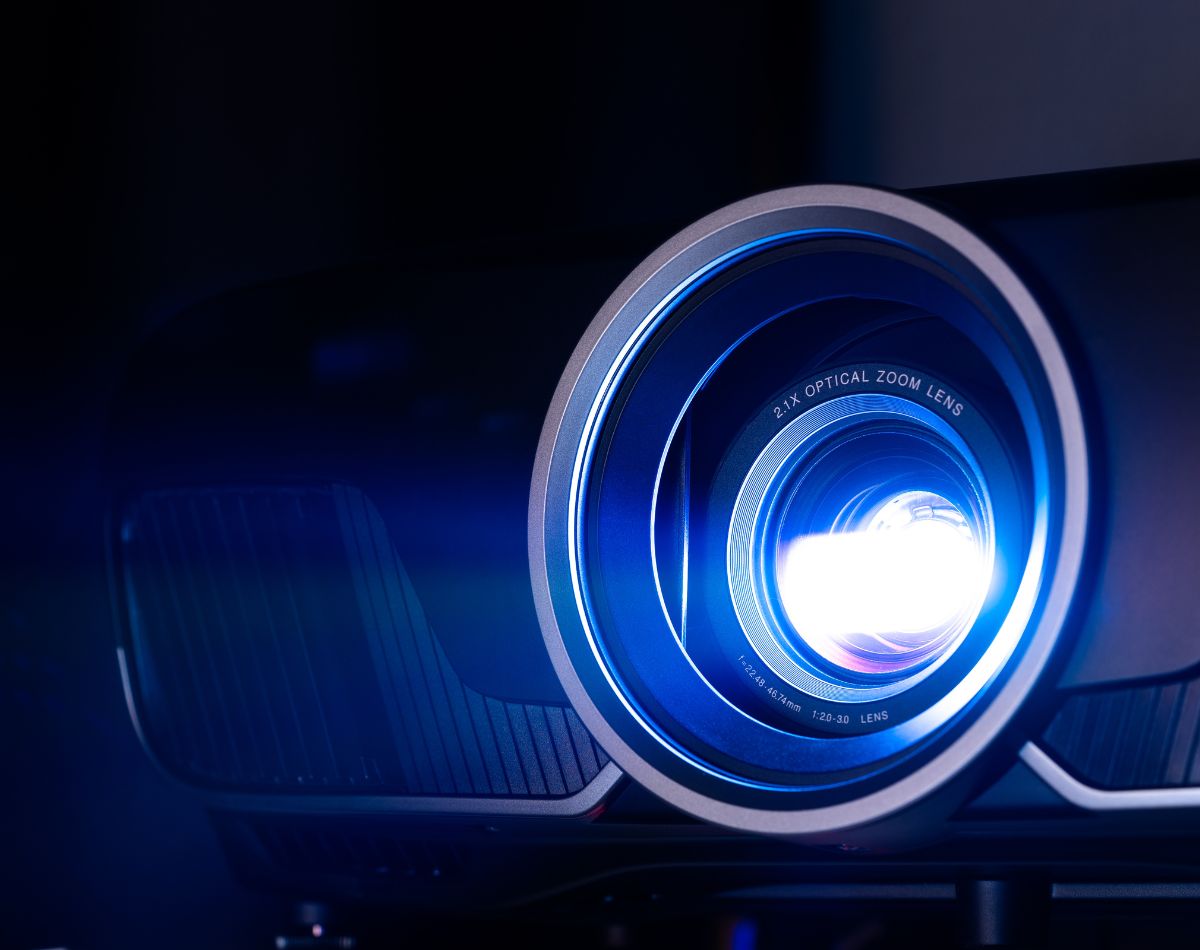In the world of visual displays, projection technology has become an essential tool, enabling everything from immersive experiences at live events to engaging presentations in classrooms and boardrooms. With advancements in digital imaging and light sources, projection technology offers diverse solutions for creating impactful, large-format visuals. However, not every solution is the same.
Whether you’re looking to create a dynamic, interactive display or simply need reliable equipment for a presentation, this guide will walk you through the essentials of projection technology. We’ll cover how projection works, explore popular types like LCD, DLP, and laser projectors, and provide insights into which type best suits your specific needs.
How Does Projection Technology Work?
Projection technology transforms digital or analog media into large-scale visuals by projecting an image onto a screen or other surface. This process involves a few key components:
- Light Source: The heart of any projector is its light source, which illuminates the image. Modern projectors often use lamps, LEDs, or lasers as the primary light source, each impacting brightness, color accuracy, and longevity.
- Image Processor: Once the digital signal is received, the image processor translates it into a visual format that can be projected. This technology is often LCD (Liquid Crystal Display) or DLP (Digital Light Processing), which use unique methods to create the image on the screen.
- Lens and Optical System: The lens focuses the processed image and projects it onto the screen, allowing you to adjust the image size and clarity based on the setup.
Each of these components plays a role in defining the quality, brightness, and color accuracy of the projected image. Different technologies, like LCD and DLP, use these components in unique ways to create the ideal projection for specific environments and purposes.
Types of Projectors
With a wide range of projection technologies available today, it’s essential to understand the unique features of each.
LCD (Liquid Crystal Display) Projectors
LCD projectors work by passing light through liquid crystal panels that control the color and brightness of each pixel. This type of projector is known for its vibrant colors and high brightness, making it a popular choice for well-lit spaces such as classrooms, conference rooms, and auditoriums. However, LCD projectors may require more frequent maintenance, as dust particles can impact the image quality over time.
Benefits of LCD Projectors:
- Bright, vivid colors, ideal for static presentations.
- Suitable for both small and large spaces.
- Cost-effective option for high-quality visuals.
DLP (Digital Light Processing) Projectors
DLP projectors use a digital micro-mirror device (DMD) to create images, where thousands of tiny mirrors tilt to control the amount of light reflected. This technology delivers high contrast and sharp images, especially for high-definition content. DLP projectors are often praised for their compact design and lower maintenance requirements since they are less susceptible to dust interference than LCD projectors.
Benefits of DLP Projectors:
- High contrast ratio and sharp images, great for videos and detailed graphics.
- Compact design, ideal for portable and home theater setups.
- Low maintenance due to a sealed chip design that reduces dust buildup.
Laser Projectors
Laser projectors use a laser light source instead of traditional lamps or LEDs, providing exceptional brightness and longer-lasting performance. Known for their high efficiency, laser projectors are often preferred in large venues or environments requiring long hours of continuous use. They offer outstanding color accuracy and consistency, and many laser projectors are virtually maintenance-free, which makes them a reliable option for demanding settings.
Benefits of Laser Projectors:
- Long-lasting, high-efficiency light source that maintains brightness over time.
- Excellent color accuracy and stability, ideal for professional applications.
- Minimal maintenance, reducing the overall cost of ownership.
Interactive Projectors
Interactive projectors add an additional layer of engagement by allowing users to interact directly with the projected image. Often used in classrooms, training environments, and collaborative workspaces, these projectors respond to touch, stylus input, or gesture controls. Interactive projectors are especially valuable for educational settings, where they enhance student engagement and create an immersive learning experience.
Benefits of Interactive Projectors:
- Engages users with interactive features, ideal for educational and collaborative environments.
- Allows for touch or stylus input, making it highly versatile for presentations and learning.
- Encourages collaboration and audience participation in real time.
Selecting the right projector technology often comes down to specific performance needs and the environment in which the projector will be used. Below, we compare the most popular options—Laser, LCD, LED, and DLP projectors—highlighting the differences that can help you make the best choice for your setup.
Comparing Projector Technologies
Laser vs. LCD Projectors
Laser and LCD projectors each have distinct strengths, making them suitable for different use cases.
- Brightness & Color Accuracy: Laser projectors offer superior brightness levels and color accuracy that remain consistent over time, making them ideal for large venues or professional settings where high-quality visuals are critical. LCD projectors also deliver bright, vibrant colors but can struggle with color accuracy over extended periods as the light source degrades.
- Longevity & Maintenance: Laser projectors are built for durability, with a long-lasting light source that can outlive traditional lamps for thousands of hours. This means less frequent maintenance and reduced costs over time. LCD projectors, however, may require more regular maintenance to maintain optimal image quality.
- Ideal Uses: Laser projectors are best suited for professional presentations, large events, or settings where brightness and longevity are top priorities. LCD projectors are often a more budget-friendly choice, fitting well in classrooms and mid-sized conference rooms.
LED vs. DLP Projectors
LED and DLP projectors each have unique qualities, making them suitable for different environments and applications.
- Energy Efficiency: LED projectors are known for their energy efficiency and longer lamp life, making them an eco-friendly option that reduces the frequency of replacements. DLP projectors, while slightly less energy-efficient, are still a compact, powerful choice with high-quality image output.
- Image Contrast & Sharpness: DLP projectors excel in contrast and sharpness, especially in high-definition settings, making them ideal for home theaters and presentations where detail matters. LED projectors, though slightly less sharp, provide consistent color over a longer period and are generally more resistant to image degradation.
- Portability & Setup: LED projectors are often compact and portable, making them ideal for smaller spaces or setups that require easy mobility. DLP projectors are also available in compact models but are known for their robust performance and sharp image quality.
When selecting between these technologies, consider factors such as:
- Environment (for example, classroom, boardroom, large event space)
- Frequency of Use (occasional versus continuous operation)
- Maintenance Preferences (higher upfront cost versus lower maintenance)
Both laser and DLP projectors are top performers for long-term use in professional or high-definition environments. LED and LCD projectors are excellent for everyday presentations and educational settings, especially where budget considerations are a factor.
Understanding Light Projection Technology
The choice of light source impacts not only a projector’s image quality but also its efficiency, maintenance needs, and lifespan. Modern advancements in light sources have expanded the range of applications and increased the visual possibilities for projectors. Here’s why light sources matter and how to decide based on specific projection needs:
The Role of Light Source in Projection Performance
- Brightness and Clarity: Different light sources bring varying levels of brightness. For example, laser light is known for maintaining consistent brightness over long durations, which is ideal for large, open environments like theaters and event spaces. In contrast, LEDs offer stable color quality and are great for smaller, controlled environments.
- Energy Efficiency and Lifespan: LEDs and lasers lead the pack in terms of energy efficiency. Unlike traditional lamps, which require periodic replacements, LEDs and lasers offer longer lifespans, making them cost-effective in high-use scenarios like public installations or classrooms.
- Maintenance Requirements: Traditional lamp-based projectors often require more upkeep due to bulb replacements and cooling needs, while laser and LED projectors generally have lower maintenance demands, making them ideal for continuous operation.
The Future of Light Projection Technology
The market is seeing new hybrid projectors that combine laser and LED technology, offering enhanced brightness with energy efficiency. This blend aims to bring the best of both worlds for versatile environments. With a growing emphasis on sustainability, laser and LED projectors are paving the way as eco-friendly alternatives to traditional lamps, offering reduced energy consumption and less frequent need for component replacements.
What is Projection Mapping Technology?
Projection mapping is an innovative technique that takes projection technology beyond traditional flat surfaces like screens or walls. By using specialized software and projectors, projection mapping allows visuals to be projected onto irregularly shaped objects and surfaces, turning any physical space into a dynamic visual display. This technology has become popular in events, advertising, art installations, and architectural lighting, enabling immersive, larger-than-life experiences. Learn more about projection mapping in our comprehensive guide here.
Trust Starlite as Your Projection Technology Partner
Projection technology has evolved into a powerful tool for creating impactful and immersive visuals across a range of settings, from boardrooms to stadiums. Understanding the different types of projectors—whether LCD, DLP, laser, or interactive—empowers you to select the right equipment that aligns with your environment and needs. Each technology has its unique strengths, and factors like light source, maintenance needs, and image quality play a significant role in the decision-making process.
As innovations like projection mapping push the boundaries of what’s possible, projection technology continues to redefine the ways we experience visuals. Whether you’re planning a large-scale event, looking to upgrade your classroom’s interactivity, or simply need reliable equipment for presentations, the right projector can transform your visual goals into reality. The experienced team at Starlite can help you bring your vision to life with the latest in projection technology.

